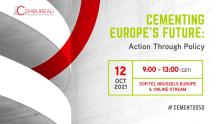
The EU's proposed CBAM mechanism is designed to address the risk of carbon leakage. This occurs when companies transfer production to countries that are less strict about emissions, meaning that global emissions would not be reduced.
CEMBUREAU says that the co-existence of the new CBAM mechanism and the existing free allocation process on carbon leakage is essential as the CBAM system is rolled out.
The European Commission says CBAM is required as Europe’s efforts to go climate-neutral by 2050 could be undermined by lack of ambition from its international partners. CBAM would put a carbon levy on imports from countries that are less-advanced in addressing climate change.
Following the adoption of the Environment Committee report on 5 February, it is to be considered in the European Parliament’s plenary session in March. The European Commission is expected to deliver legislative proposals on CBAM as part of its “Fit for 55% package” in June 2021.
Commenting on the moves, CEMBUREAU CEO Koen Coppenholle said: “A CBAM is a useful tool to address the imports of products not subject to similar carbon constraints in the European Union and therewith mitigates the carbon leakage risk allowing the European cement industry to deliver low-carbon investments.
"The Environment Committee’s report highlights some key points in this respect, notably that a CBAM should result in EU and non-EU suppliers competing on the same CO2 costs basis; that the scope of CBAM should be wide to avoid market distortions, and that both direct and indirect emissions should be included."
However, Coppenholle added that a pragmatic approach is needed regarding the interaction of CBAM with the existing carbon leakage measures. He said that a full co-existence of CBAM and free allocation is essential to minimise risks for the industry, avoid distortions on the internal market, safeguard the competitiveness of exports, and provide certainty for investors.
"Such full co-existence, which can be done without any risk of 'double protection', should last at least until the end of phase IV of the EU ETS in 2030, following which the CBAM will be hopefully mature and expanded to cover most sectors of the economy," said Coppenholle.
Environment MEPs say CBAM should be part of a broader EU industrial strategy and cover all imports of products and commodities under the EU Emissions Trading System (ETS). They add that by 2023, and following an impact assessment, it should cover the power sector and energy-intensive industrial sectors like cement, steel, aluminium, oil refinery, paper, glass, chemicals and fertilisers, which continue to receive substantial free allocations, and still represent 94% of EU industrial emissions.
To prevent carbon leakage, carbon pricing under the CBAM should be linked to the price of EU allowances under the EU ETS, they add.








